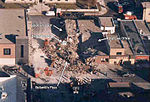Rox Park
1948 establishments in Minnesota1971 disestablishments in MinnesotaDemolished sports venues in MinnesotaMidwestern United States sports venue stubsMinnesota building and structure stubs ... and 4 more
Minnesota sport stubsSports venues completed in 1948Sports venues demolished in 1971Sports venues in Minnesota
Rox Park, also known as Municipal Stadium, was a baseball park located in St. Cloud, Minnesota. It opened in 1948 and served as the home stadium for the minor league St. Cloud Rox through the 1970 season. The stadium was demolished in 1971 and was replaced by a ShopKo department store, a Byerly's grocery store and a small enclosed two story mall. Home plate was retained and located in the entryway of the ShopKo store until the early 1990s. Its seating capacity fluctuated from 5,000 in 1947 to 3,600 in 1949.
Excerpt from the Wikipedia article Rox Park (License: CC BY-SA 3.0, Authors).Rox Park
25th Avenue South, St. Cloud
Geographical coordinates (GPS) Address Nearby Places Show on map
Geographical coordinates (GPS)
| Latitude | Longitude |
|---|---|
| N 45.552222222222 ° | E -94.189166666667 ° |
Address
25th Avenue South
56301 St. Cloud
Minnesota, United States
Open on Google Maps





